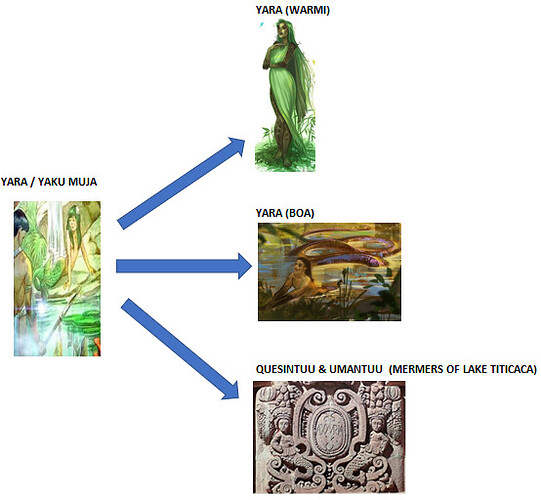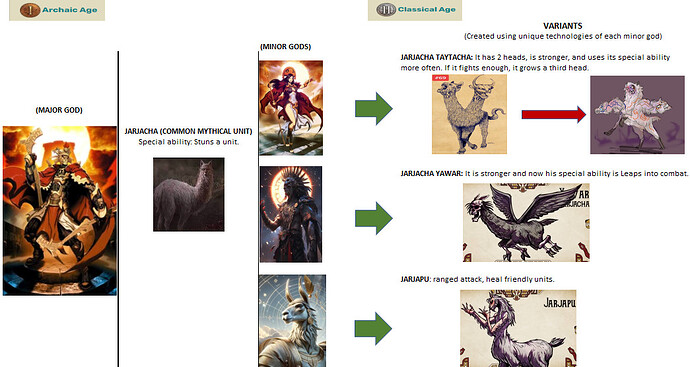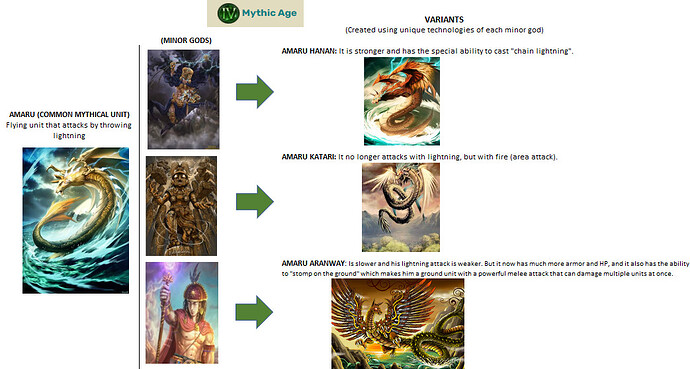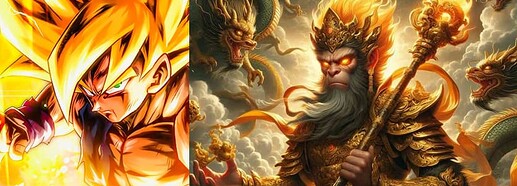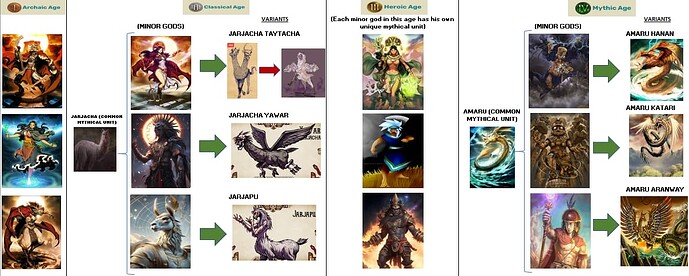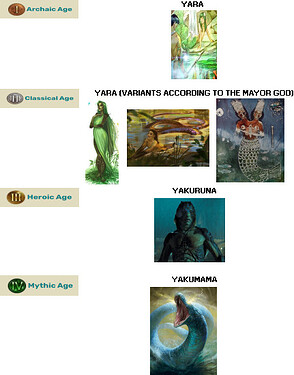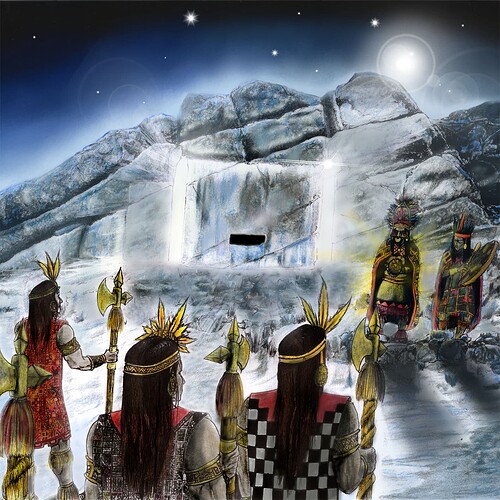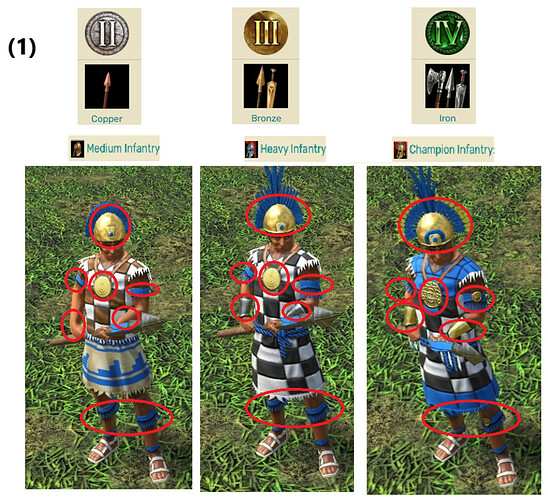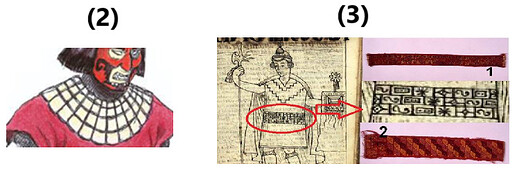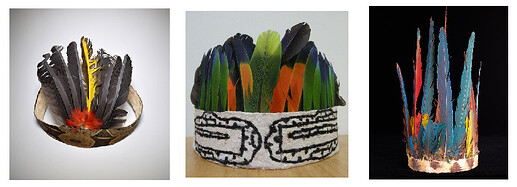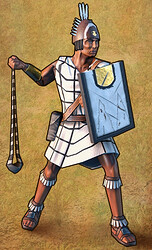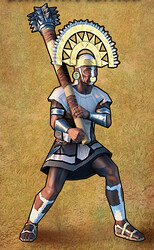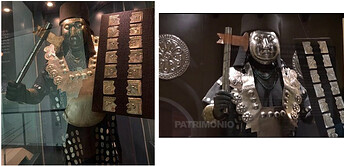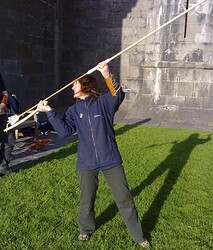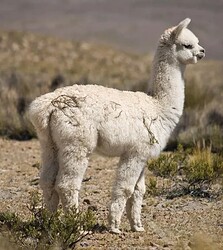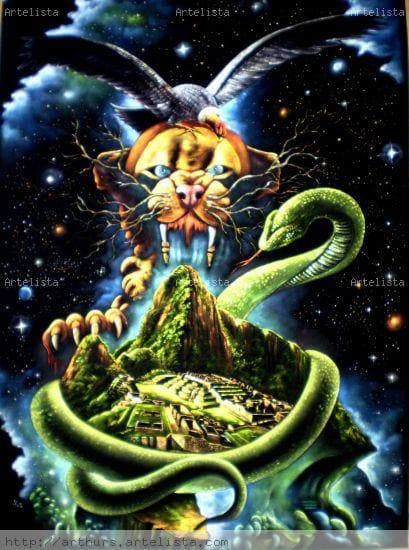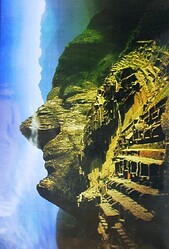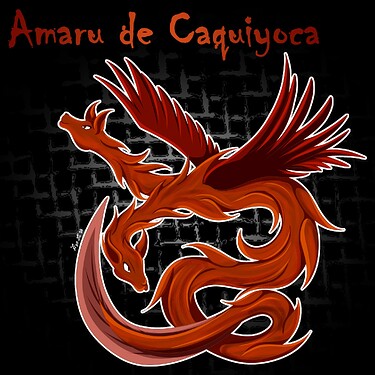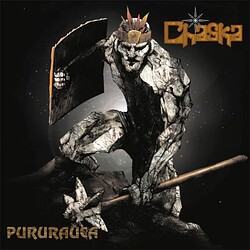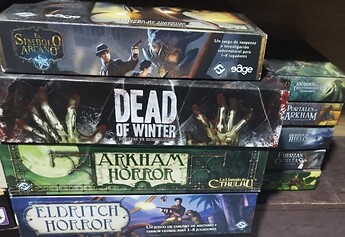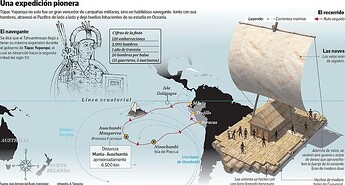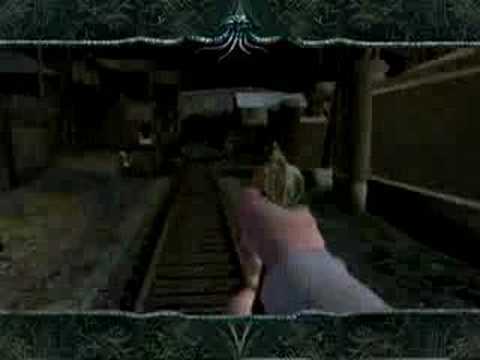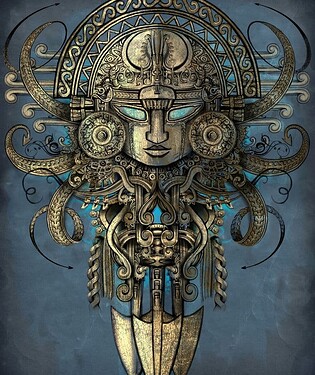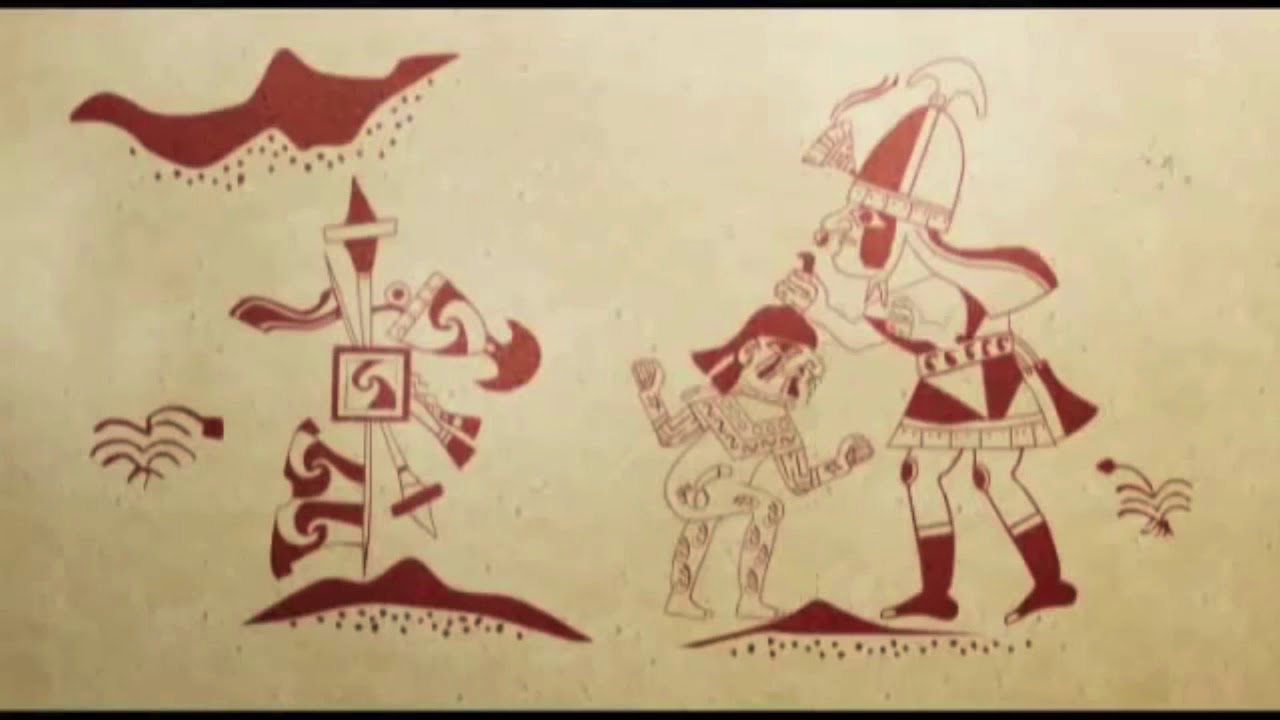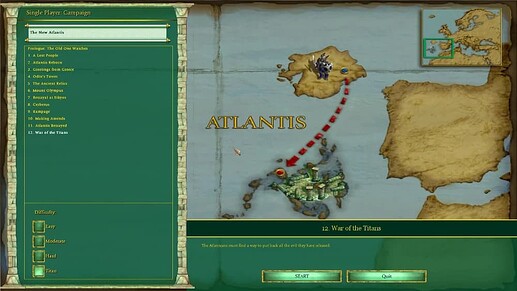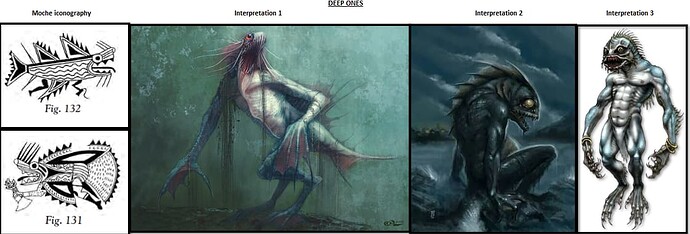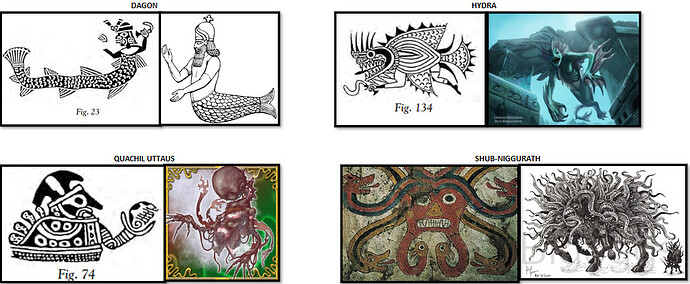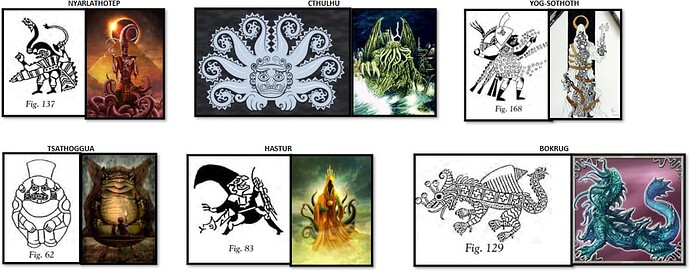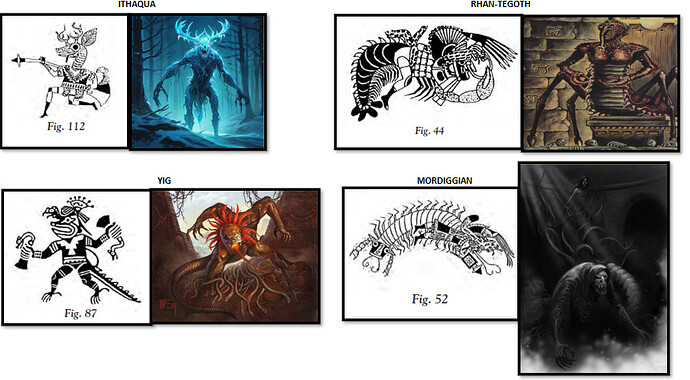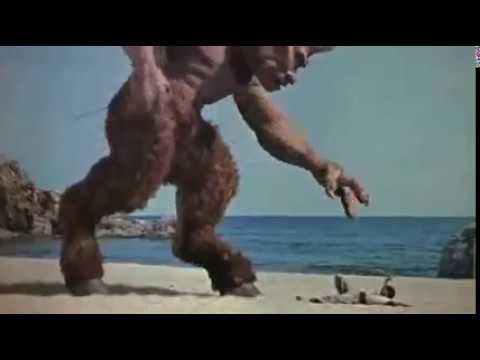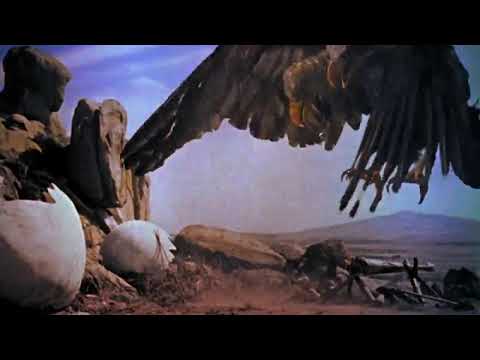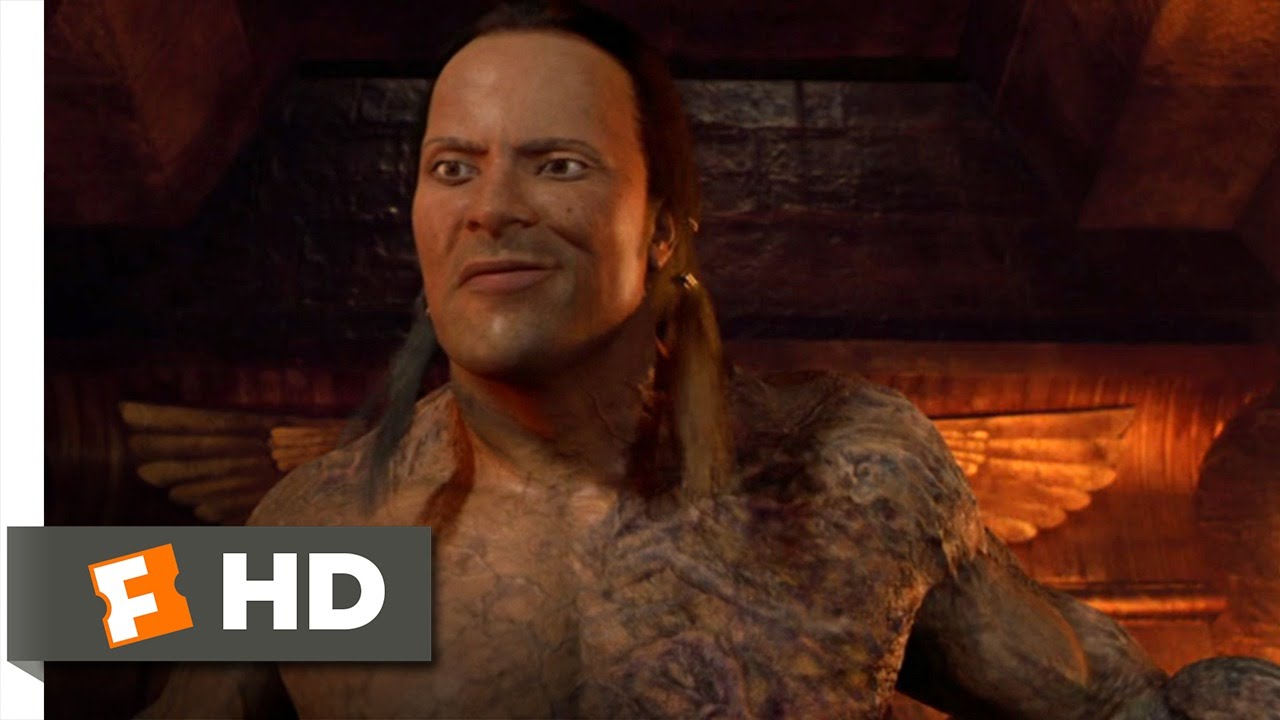Lemuria is a very modern term for a discredited theory that turned into pseudoscience, so I wouldn’t want it referenced. In fact, it’s already a removed reference.
As for Mu, I heard it’s the mythological homeland of the Turco-Mongols, so I feel it should be used for that culture.
That’s the only hybrid that makes sense in my opinion.
I really love the idea of adding a Numidian god to the Egyptian pantheon that has a black Pharaoh and maybe some other units too.
Yeah Lemuria is a 19th century theory before people knew about plate tectonics.
Mu is the homeland of like half the cultures of the earth, Mayans, Indian, Sumerians, Egyptians and so on.
Like a conspiracy theory?
Anyway, if it can cover so much it’d be better not to use it at all then.
I already dislike the Atlanteans, Mu is like the same but worse.
But also Trojans are the linked to many other cultures around Europe.
Both Romans and Britons are descendants of Troy mythologically.
Hi!
Regarding the fact that they share the same name, this could be due to various factors; however, I want to take this opportunity to make some clarifications and give a preview of my concept for the hypothetical Inca faction.
Regarding the “Iara” from Brazilian mythology, it’s the story of a young woman who turned into a mermaid. On the other hand, the Yaras from Andean-Amazonian mythology are more akin to the Naiads of Greek mythology, with different types of Yaras in this mythology.
Now, I’ll explain how I think the mythical units of the Inca faction should be.
To start, I want to remind you of a part of your childhood with the Disney movie “The Emperor’s New Groove”
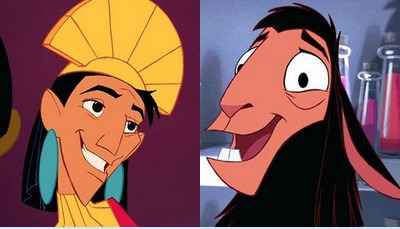
As you may know, the writers of this movie traveled to Peru to draw inspiration from Andean folklore; and many will remember that “Cuzco” (llama form) caused fear among the villagers, who even called him the “demon llama”. This is because they were actually referring to the “Jarjacha”.
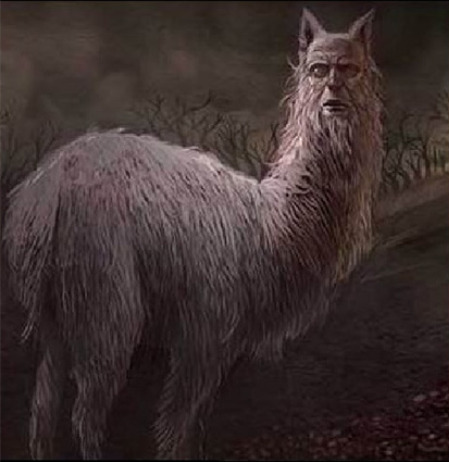
The Jarjacha is a carnivorous Andean mythical creature that “hypnotizes” with its gaze and then devours its prey, starting with the brain. Now, for gameplay purposes, I came up with the following:
I hope the graphic is understandable. As you can see, the Jarjacha is a common mythical unit but has different variants depending on the minor god chosen. This idea came to me after seeing the Sphinx in AoM R (which changes appearance in each update), and I thought, “what a waste of potential.” So, I came up with the idea of variants for some mythical units.
If the Incas are included in AoM, they wouldn’t have cavalry, so I thought the Jarjacha could partly make up for this lack (besides using the widespread idea that llamas can be ridden).
For Age 3 (Heroic Age), I thought each minor god could have its own unique mythical unit, as Age 3 is more decisive in the game and adds more variety to the Mythical Units.
For Age 4 (Mythic Age), the concept of “Variants” will be replicated with the Amaru.
And of course, there may also be minor gods that simply “reduce the resource and/or population costs of this specific mythic unit”, which would give the ability to acquire many base mythic units.
I am also reading the rest of your comments and many concepts seem interesting to me. For now I do not have time to reply to you with my opinions and ideas so I will reserve that for another post ![]()
*PD: Para los interesados en la mitología andina, les dejo este video (en español), recomiendo encarecidamente ese canal ![]()
Wait Britons have a mythic link to Troy? I know of Aeneas (probably butchered his name sorry) for the Romans but what was the myth linking Britons to Troy?
Greetings to all!
I appreciate everyone sharing their thoughts on this topic. I created this thread to organize and expand on ideas for various pantheons, as well as to clarify certain aspects of them.
One recurring and often controversial topic is Christianity. I want to preface this by saying that this is my personal opinion, and I’m open to educated debate. As a Protestant Christian with a father studying to become a reverend, and a lover of different mythologies, here’s my perspective:
Firstly, Age of Mythology (AoM) is a game that seeks to create its own mythology inspired by others, so it takes creative liberties. The topic of including Christianity in AoM is controversial, especially when focusing on the early church, which ties into Roman, Jewish, and even Islamic histories. Some users have suggested incorporating Christian folklore as part of medieval European myths, such as vampires, werewolves, fairies, witches, etc.
For context, I’ll refer to two of my favorite fantasy authors: J.R.R. Tolkien and Akira Toriyama.
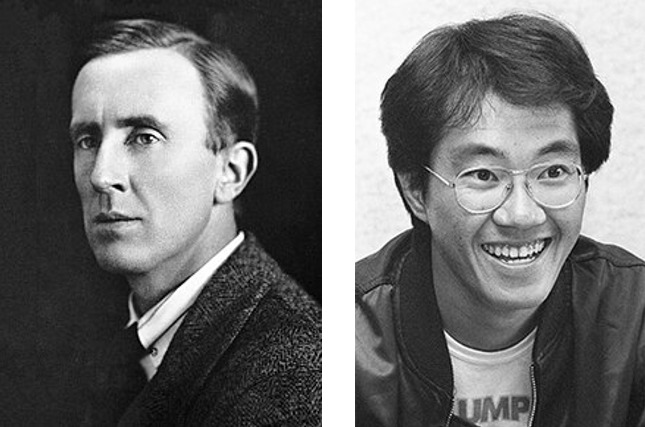
Tolkien, a devout Catholic and WWI veteran, masterfully wove different mythologies and his own beliefs into his work. He was heavily inspired by Norse mythology (e.g., the dwarves and the rings of power) but also subtly incorporated Christian values and themes. For example, the Valar in The Silmarillion are akin to angels, serving Eru Ilúvatar (God). Melkor, the most powerful Valar, mirrors the biblical fall of Lucifer. Tolkien also drew inspiration from the archangel Michael when creating Manwë, the leader of the Valar, who, like Michael, defends order and good against evil (Melkor).
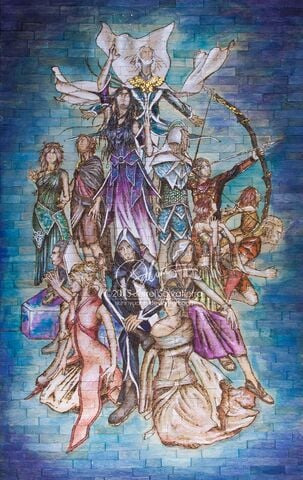
Akira Toriyama’s Dragon Ball, on the other hand, draws inspiration from the Chinese novel Journey to the West. The protagonist, Son Goku, is based on Sun Wukong, the Monkey King, with abilities like a flying cloud and a staff that can change size. Toriyama also incorporated Japanese folklore, with characters like Kami-sama and the kai, which resemble Shinto gods. Moreover, Toriyama was inspired by Western works of fantasy, such as Superman (Goku coming from another planet) and Terminator (Trunks coming from the future to stop the android threat).
Many works of fantasy also draw parallels with Christian beliefs. For example, Anakin Skywalker in Star Wars was conceived by the Force, echoing the story of Jesus. There are countless other examples, but I won’t delve into more controversial territory.
IN CONCLUSION:
AoM’s own mythology grants it the creative freedom to introduce civilizations, like a Roman Christian faction, without directly referencing Christian beliefs (similar to Tolkien’s approach). Its established lore allows for the inclusion of civilizations and gods that might otherwise be difficult to incorporate, such as the Atlantean faction. For instance, I once suggested a Lovecraftian-inspired faction with the Moche/Chimú civilization serving as their physical manifestation. While some may find this illogical or even offensive, the game’s lore could provide the rationale: chaotic gods (Lovecraftian gods seeking to awaken from their slumber) rruling over the Moche/Chimú until other gods (Zeus, Ra, Odin, etc.) intervened to free this civilization and put archetypal gods in their place (Ai Apaec, Ni and Si). Or Ai Apaec could even be an avatar of Nyarlathotep—the possibilities are endless.
So, feel free to share your opinions and proposals! Let’s keep it constructive, avoid confrontations, and remember these are just ideas, not demands ![]()
I would really like to see Maya after Chinese.
I think it would be nice to have big dlc with campaign and big god rehash.
I really like the concept of each minor god sharing 2 major gods (not fan of Freyr as major god) and also would be happy to see 1 female god in each pantheon as major god(Freyr I’m still looking at you!).
Also if we will get goddes like Demeter it would fit better for her to have Hephaestus god power with age progression (1res per sec/2 res per second/3 res per secons/4 res per second)
So I would like to see new gods line-up for existing nations like this
Greeks - Zeus, Poseidon, Hades, Demeter
Egyptians - Set, Ra, Isis, Amon
Nors - Odin, Thir, Loki, Frija
Atlanteans - Coeus, Cronos, Gaia, ############### Chinese - Fu Xi, Nu Wa, Shennong, ?Longwang?
The next I think should be from Latin America so it would fit to add Maya or Aztecs.
Hello.
As I said, I created this thread to gather information on various pantheons (as well as possible variants) and concepts that could be added to AoM. So I’m going to present my hypothetical Inca faction for AoM, in the hopes of raising awareness, inspiring, and avoiding “repeating concepts” with other pantheons that may be suggested.
Also create possible expansion packs (2 additional gods)
NAVAL UNITS
Regarding the generation of divine favor, the concept will be based on “Wakas” (wak’a). The concept of Wakas is very broad, but to summarize, for the Incas, they were sacred places where sacrifices and offerings were made. In the game, the Waka will function as a building that combines economic structures (like the Granary and Storehouse) with the Sentry Tower. In other words, it’s a building where resources are deposited and which also fires arrows as defense (inspired by the Tambos). The first two Wakas will be cheap or even free (in exchange, there will be no Sentry Towers near the Town Center in skirmish games). Wakas will also have the ability to “deconstruct,” returning 50%-70% of the initial investment.
DIVINE FAVOR: This will work similarly to the Export system from AoE 3, where a percentage of your collected resources is offered to the Wakas, which in return grant divine favor. To set the offering percentage, players will need to select a Waka.

HEROES: A fusion between the Greek and Norse hero systems. There will be only four heroes (one per age), but they are generic, regardless of the major god chosen.
- Age 1: Apuq (Captain): A melee hero.
- Age 2: Amauta (Wise): A melee hero with the ability to empower buildings (like the Egyptian Pharaohs).
- Age 3: Villaq Umu (High Priest): A ranged hero who can heal allied units.
- Age 4: Cápac (Royal Noble): A melee hero with a special morale boost ability (similar to Arkantos).
Regarding basic units, I haven’t fully refined the concept yet, but I believe there should be three soldier training buildings:
- Tambo: Basic barracks where Chuki (lancers), Wach’ina (archers), and Runancha (scouts, who serve as shock infantry) are trained.
- Kallankas: Barracks for nobles, where elite troops are trained. Units here include Huaraca (slingers), Champi (mace-wielders with area damage and bonus damage against buildings, similar to AoE 3 Maceman), and Pachak (centurions, more powerful but slower shock infantry compared to Runancha).
- Pucará: Castles or fortresses, where Kamayuk are trained. These noble soldiers have a melee attack with a 1.5 range and can also attack flying units using slings. They have bonus damage against myth units.
I hope you enjoy reading my concept as much as I enjoyed creating it ![]()
They removed Lemuria from the lore? Lame.
INCAN HEROES AND UNITS
1) HEROES
General Concept:
- Incan heroes will have random personal names, similar to the Nordic heroes in Age of Mythology. This reinforces the idea of mortality: if they die, they are replaced but not revived.
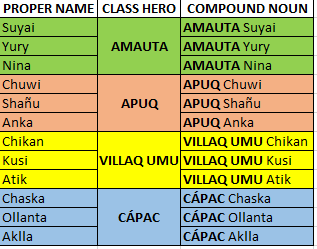
Heroes by Age:
-
Age 1: Amauta (Wise Man)
- Description: Hero with mediocre melee attack using a staff, highly effective against myth units (higher damage multiplier against myth units than other heroes).
- Special Ability: Enhances already constructed buildings, accelerating unit production and technology research.
- Cost: Food and wood.
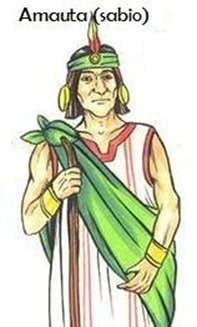
-
Age 2: Apuq (Captain)
- Description: A fast hero acting as shock infantry.
- Weapon: One-handed axe.
- Cost: Food, gold and favor.
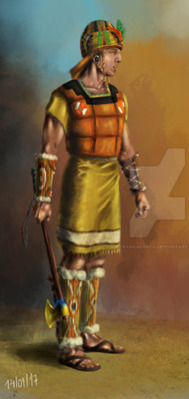
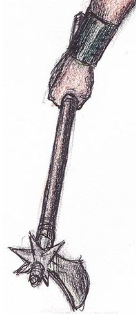
-
Age 3: Villaq Umu (High Priest)
- Description: A fragile hero armed with a scepter, possessing a powerful magical attack (only against myth units, similar to Pharaohs).
- Ability: Can heal allied units.
- Cost: Wood, gold, and favor.
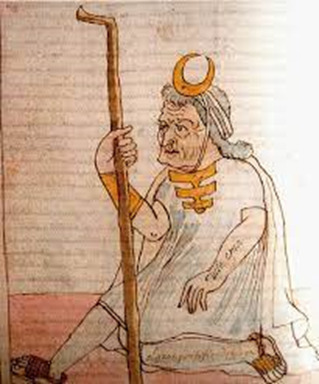
-
Age 4: Cápac (Royal Noble)
- Description: Melee hero armed with a halberd.
- Special Ability: Morale boost, similar to Arkantos.
- Cost: Gold and favor.
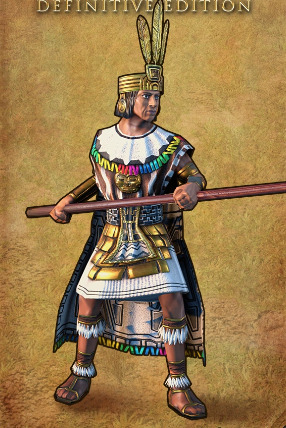
2) INCAN ARMORS
A) Basic Units (Tambo)
-
Chuki (Spearman)
- Model: Inspired by the spearmans from Age of Empires 3.
- Armor Components: (1) Metal disc on the chest, helmet, bracers, and metallic shoulder straps.
- Armor Evolution:
- Materials: (1) Copper, silver, and gold, with increasing detail for each upgrade.
- Additional Details: Leg straps will increase in size with each upgrade. Will include a metal armor around the neck. (2)
- Incan Belt: Will be incorporated into the design and may include metallic elements. (3)
-
Wachina (Archers)
- Armor: Similar to that of the spearman but lighter.
- Distinctive Features: Amazonian crowns and facial paints.
-
Runancha (Scout, Shock Infantry)
- Weapon: Macana, a light and fast weapon.
- Equipment: armor similar to that of the spearman; smaller shields & helmets.
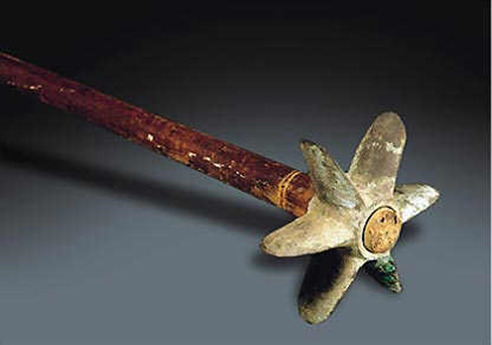
B) Noble Units (Kallankas)
-
Design: Heavy use of metal armor for all Kallanka units.
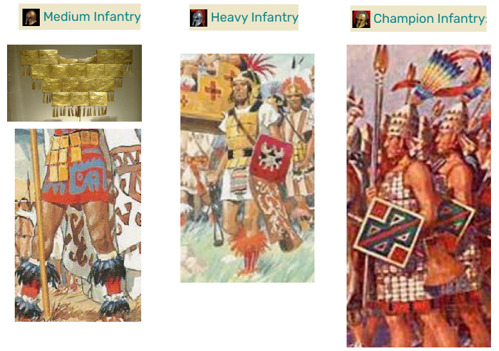
-
Pachack (Shock Infantry)
- Weapon: Tuccina (Andean sword).
- Function: Tough infantry in melee combat, but vulnerable to ranged attacks, similar to the Spanish Rodelero in AoE 3. Although more durable than other shock units, they are still weak to anti-cavalry units.
- Special ability: Throws a boleadoras every so often to slow down an enemy (extra damage against cavalry).
-
Huaraca
- Weapon: Sling that throws fiery projectiles at long range, effective against units and buildings.
- Weapon: Sling that throws fiery projectiles at long range, effective against units and buildings.
-
Champi
- Weapon: Mace wielder with area damage, also deals extra damage to buildings.
- Weapon: Mace wielder with area damage, also deals extra damage to buildings.
C) Royal Units (Pucará)
- Kamayuk
- Design: Based on the armor of the Lord of Vilcabamba (inspired by the Wari Empire).
- Additional Equipment: Metallic masks (creative freedom allowed).
- Weapon: Turpuna (6.30 meter / 20.7 foot-long spear, melee infantry with 1.5 range).
- Special Ability: Deals additional damage to myth units.
- Apu Randin
- Armor: Same armor as the Kamayuk, but lighter.
- Weapon: Javelins, being thrown by means of estolicas.
- Characteristics: Shock infantry with ranged damage, eals additional damage to myth units, they are very expensive.
Soldier Upgrade System:
Since the soldiers from each military building share the same armor design (with variants), it would be practical for soldier upgrades to be applied per building. This would be similar to the War Academy system used by the Chinese in AoM EE: medium Tambo soldiers, heavy Tambo soldiers, and champion Tambo soldiers. The same system would apply to the soldiers from the Kallankas and Pukarás.
![]()
Caravan Animal:
Since llamas are already used by the Atlanteans (and I hope a future campaign explains why), the Inca faction could use alpacas for their caravans instead of llamas.
Titan: Stone Giant
According to Inca legend, the god Wiracocha, when creating the world, attempted to create the first intelligent beings by creating giants. However, these giants rebelled against Wiracocha, so he transformed them into stone and later sent a flood to destroy them. This Stone Giant could be the titan for the Inca faction.
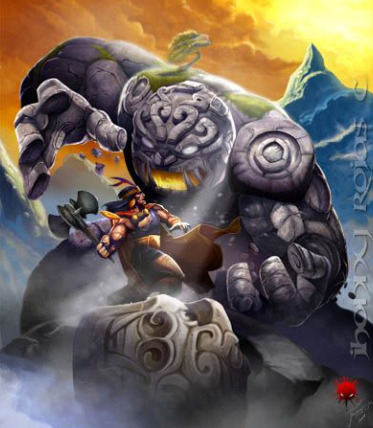
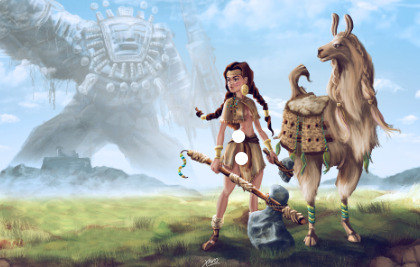
Divine Favor System:
The idea of using the export system as a way to gather divine favor intrigued me because the export symbol is the tea leaf, while Incan offerings to the Wakas (sacred places or deities) often included coca leaves.

Creative Concept Disclaimer:
Please note that this is just my personal concept. I understand there may be some inaccuracies (I’m not perfect), and I’ve taken some creative liberties.
Final Reflection:
Building a civilization for Age of Mythology (AoM) is no easy task. I developed this concept for the Inca faction due to my nationality, my knowledge of Spanish, and some understanding of Quechua. I hope that this model of civilization can inspire other users and help them better organize their own ideas ![]()
Edit:
I improved and added some concepts.
Erratum
This creature is not called Simpara, but SIMPIRA.
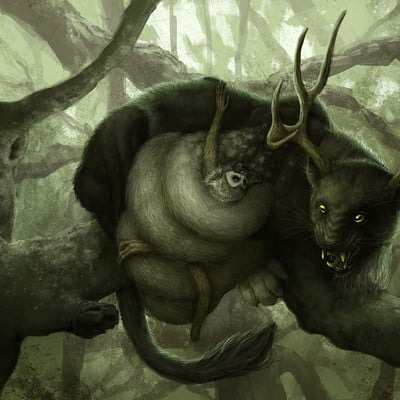
Technically, this is not an Inca god, but rather a representation of Hanan Pacha:
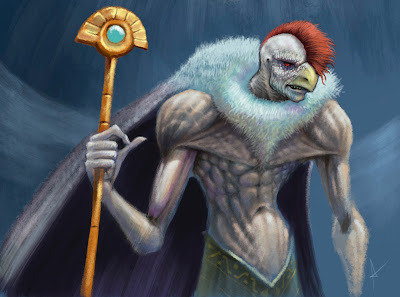
Let me explain: In Inca cosmology, there were three Pachas: Hanan Pacha (Heaven), Kay Pacha (the Earth), and Ukhu Pacha (the Underworld). In this worldview, each Pacha was represented by an animal: the condor, the puma, and the serpent.
Another important element in Inca cosmology is that Wiracocha is called the “creator god,” but this refers to the god who created civilization. Wiracocha’s role was to organize and civilize the world, not to physically create the planet.
In Inca cosmology, there was a CREATOR GOD OF EVERYTHING (with an intriguing resemblance to the Judeo-Christian God) known as the “Nameless God.” This concept is similar to a primordial deity superior to all other gods, including Wiracocha. The “Nameless God” resembles the idea of an invisible and omnipotent god.
I considered the possibility that this “Nameless God” might be a major god, while the animals representing the Pachas (the Condor, Puma, and Serpent) could be minor Inca gods. However, out of respect for my own beliefs in an all-powerful primordial God, I dismissed this idea.
Additional Elements That Could Be Used:
- The Inca Hero Villaq Umu (High Priest) should be renamed to Willka Uma (Lesser Priest). This would allow for the possibility that some Myth technologies could improve specific hero classes:
- Amauta = Amauta Kuna (Amauta of the nobles)
- Apuq = Apuq Qhapaq (Captain with a noble title)
- Willka Uma = Villaq Umu (High Priest)
- Cápac = Cápac Auqui (Imperial prince, not necessarily the heir)
-
AUCAYOC, the god of war.
-
Sleeping Giants: Regarding the Stone Giant that could be used as Titan, there are current legends about “sleeping giants” because many mountains in the Andes range have human-like shapes. One of the most famous examples is the mountain of Machu Picchu (note that the photo has been enhanced to better show the face).
-
Inca Siege Weapons: I also thought of incorporating the Chachapoyan Ballista, which could be built in the Pukará. Since the Incas won’t have Draft Horse technology, it would make sense for this weapon to need to be packed to move and unpacked to attack (similar to the Trebuchets in AoE 2). This weapon could hit multiple units and be devastating to buildings. It could be called Hatun Wachi (big arrow).
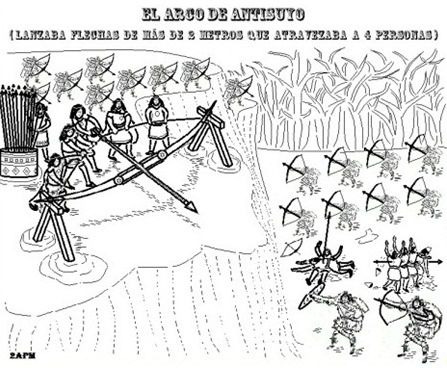
-
Sinchi: This means “strong, tough, sturdy, brave,” and can also mean “soldier.” I like the name but I’m unsure in what context to use it. I have used weapon names or military ranks to name units.
-
Chasqui: I’m also not sure how this could be integrated. It could be the initial explorer, but I would like it to have additional uses, such as the Chasqui being able to construct free buildings over a long period of time (like the Architect in AoE 3) or being the only Inca unit able to build important structures like Wakas, Temples, and Pukarás. This would be more related to gameplay and balance, so it’s beyond my capabilities.
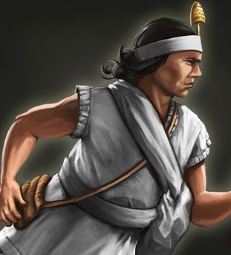
EDIT:
I forgot to mention Caquiyoca’s Amaru, the Two-Headed Amaru of Fire.
Regarding the Inca ships, the “rock, paper, scissors” system of the other factions’ ships should be maintained; if possible, the Inca ship model should be used primarily, and the Chimú ship model should not be used because I consider that they have the potential to be a different faction.
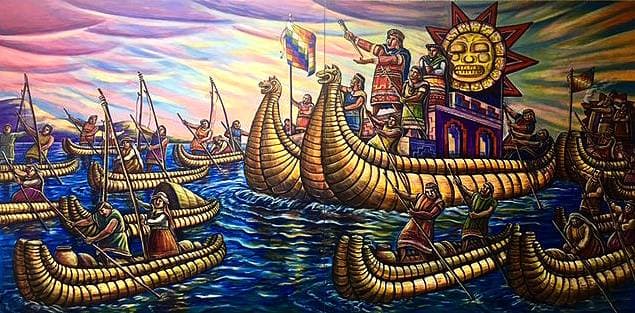
EDIT 2:
I also forgot to mention the soldiers of Pururauca
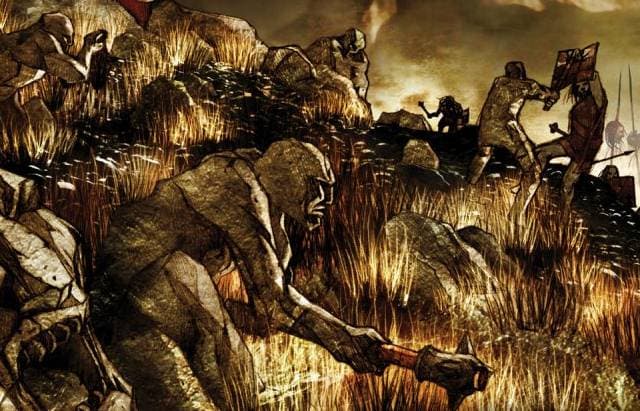
Hello everyone,
I created this topic with the idea of it serving as a “workshop” where we can gather information about pantheons, share ideas, and discuss different approaches.
And although I was hoping for more participation in possible ideas for pantheons, I at least want to express my own ideas for pantheons that could be added to AoM in the hope of inspiring other users to do the same.
With this new idea I want to replicate the formula with which the Atlantean faction was conceived, which is a unique and exclusive civilization of AoM; with this new idea that I am going to publish I want to test the limits of artistic freedom in AoM, which is a game entirely of epic fantasy.
As promised, I’d like to share an idea I had for implementing Lovecraftian gods into AoM, using the Moche and Chimú cultures as their physical manifestation and form of worship. I know this will probably never make it into the game, but I enjoyed developing the idea, as I’m a fan of Lovecraft’s stories. It’s also interesting to note that some of Sandy Petersen’s (one of AoE’s designers) games, such as Quake, have Lovecraftian influences.
To be clear, this is just a creative exercise. My goal is not to disrespect any person, culture, or the game itself. I believe history and myths are fascinating tools for creating new content.
Here are some key points on why this fusion between the Moche/Chimú and Lovecraftian mythology has potential:
1. Strategic Location
The Moche and Chimú civilizations flourished along the Pacific coast, which, interestingly, is close to where H.P. Lovecraft placed the sunken city of R’lyeh, where the great Cthulhu sleeps. There’s also solid speculation that some South American Pacific cultures reached as far as Oceania, making maritime contact with the fictional city of R’lyeh even more plausible.
2. The Importance of Gold
Gold was extremely important to the Moche and Chimú, both economically and in religious rituals. Those familiar with “The Shadow over Innsmouth” will also recognize the connection between gold and Lovecraftian gods.
3. Marine Creatures and Art
Moche and Chimú art contains many depictions of marine creatures such as octopuses, fish, and other sea beings. This visually aligns with Lovecraftian mythology, especially with the depictions of Cthulhu and the Deep Ones. This kind of symbolism creates a thematic and visual link between these civilizations and Lovecraft’s cosmic gods.
4. Sacrifices and Supernatural Powers
The Moche are known for their human sacrifice rituals, which had religious and social significance. This adds a dark and strategic element to the game, in line with Lovecraftian themes.
5. Fallen Civilization
Historically, the Moche mysteriously disappeared before the rise of the Inca. While there are theories about climate change or internal conflict, in this fusion, it could be explained as a civilization that fell under the influence of Cthulhu and other beings from the depths. This would add a touch of mystery and fatalism typical of Lovecraft’s lore, or in the AoM context, it could even be given a “more positive” outcome (as happened with the Atlanteans in the campaign).
To start, I must remind everyone that most of the information we have about the Moche religion is speculative. This is because they left no written records beyond their iconography, which, ironically, is so abundant that it suggests they had a vast pantheon of gods. Unfortunately, many of these gods remain unnamed today or are referred to by their characteristics (for example, “Crab God”). Based on my research, most Moche deities are identified by codes, such as the case of “Divinity a-F.”
Personally, “it pains, burns, and hurts” me to know that an entire mythology of an ancient culture has been lost. But focusing on the topic, I found that within Moche iconography, there are deities or creatures that resemble Lovecraftian gods. Of course, it’s not a perfect match, but at least it gives us a starting point. This is because Lovecraftian gods are often described in such ambiguous ways that they lend themselves to personal interpretation. Despite this, they still have unique characteristics that set them apart.
To begin, I’ll use the Deep Ones as an example. Here, it’s easier to explain my idea.
Now, I will present this fictional pantheon. Enjoy it ![]() :
:
-
I should also mention that there are Lovecraftian deities, like Azathoth, which are inherently complex and can have variable representations.

-
Additionally, I left out more recently created Lovecraftian deities (from the early 2000s onward, many created for role-playing games). However, some of these newer deities are quite interesting.
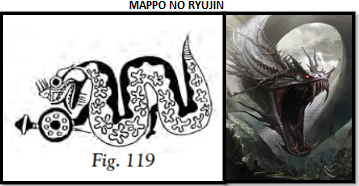
I’m still working on gameplay elements, human units, game mechanics, and similar topics. For now, I’ll leave this post here, as I wanted to publish it on Friday the 13th ![]()
![]()
Hello Again,
I’ve been working on the concept for this hypothetical Moche/Chimú faction. As I mentioned before, this is just a fan-made project based on some knowledge of history. I’m not an expert on the subject, but I am a fan of the AoE series, and I have a bit of understanding of key elements needed for creating a civilization in AoM.
To start, I’ve included some links with Moche iconography for your enjoyment and possible future use.
https://www.researchgate.net/publication/353567481_LAS_DIVINIDADES_DE_LA_CULTURA_MOCHICA
Moche Faction Concept
Civilization of Gold:
The Moche civilization (2nd–7th century AD) has interesting similarities with the Egyptians, as both were desert civilizations, though with notable differences. While Egypt thrived thanks to the Nile River, the Moche prospered near the sea, as did their descendants, the Chimú. There are fascinating parallels between these cultures, such as their extensive pantheon of gods, their dedication to working with precious metals like gold and silver, and their monumental tombs filled with vast wealth. One example is the tomb of the Lord of Sipán, which concealed over 1.2 tons of gold, 80 kilograms of precious stones like lapis lazuli and turquoise, 600 kilograms of silver, 19 copper bowls, and other relics, along with legends of an alleged curse.
For the Moche faction in Age of Mythology, I aim to reflect certain parallels with the Egyptian civilization while ensuring it maintains a unique South American identity.
Gameplay Mechanics
Gold as a Key Resource:
- Moche units will cost more gold than those of other civilizations, including their villagers (called “Yana”).
- To compensate, every time food is gathered (from any source), a small trickle of gold will be generated. This will include fishing, similar to the Chimú, who also relied on the sea.
- Like the Egyptians, Moche villagers will gather resources more slowly than those of other civilizations, but the constant gold trickle will help balance this disadvantage.
Historical Justification:
The Moche civilization flourished in the desert. Historically, in such civilizations, food, water, and irrigation infrastructure were intertwined with gold. One reason the Moche were able to farm in the desert was through the extraction of guano from islands using boats as fertilizer. I justify the gold trickle from food gathering for the following reasons:
- Collection of valuable goods from the sea, like spondylus and other treasures comparable to gold, as well as guano from islands near the coast.
- Political or economic tribute linked to agriculture and fishing, where the resources collected contributed to wealth accumulation. This also includes hydraulic infrastructure such as water wells and canals.
- Trade: Access to food encouraged interregional trade (both by land and sea), where valuable goods like gold were part of the exchange.
- Religious symbolism: The collection of food was closely tied to obtaining precious goods to maintain rituals and the power structure.
Divine Favor:
- Originally, I thought about a human sacrifice system to generate divine favor, but to avoid potential conflicts (since many would frown upon a bloody theme), I decided on a different approach.
- Divine favor will be generated by creating sacred golden objects. Each Moche temple will have between 5 and 10 slots where villagers can garrison. While villagers are garrisoned, they will generate divine favor, but in return, gold will be lost, symbolizing the use of precious metal for offerings to the gods.
- The more villagers garrisoned in the temple, the greater the amount of gold lost, but also the higher the divine favor generated. This mechanic reflects the Moche’s sacred view of gold craftsmanship, dedicating their creations to the gods to gain their favor.
UNITS
For unit creation, I will use the Chimú’s hierarchical system (as it is the one with more records). The Chimú are considered an empire because they had vassal nations at their disposal. Even the kings subdued to the Chimú empire were called “Coriec.” On the other hand, the “Alaec” (lords of the valley) were feudal lords belonging to the empire. While it can’t be confirmed that the Moche had an imperial structure, it is known that they were at least a militaristic and expansionist civilization.
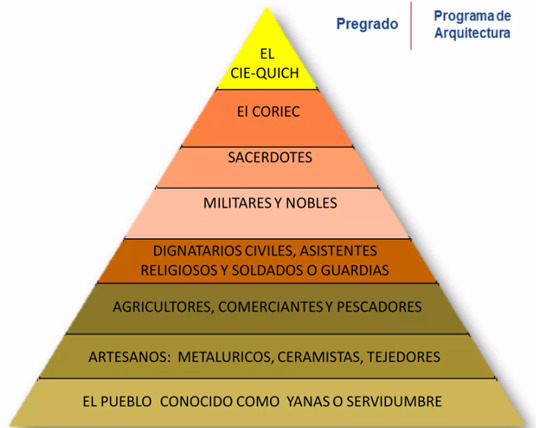
I don’t know the Muchik language, so I’ll only use a few key words.
The Moche and Chimú primarily used two weapons: maces and javelins:
- They had different types of maces, but a defining feature was that the lower end had a metal point, so soldiers using maces could also use them as spears.
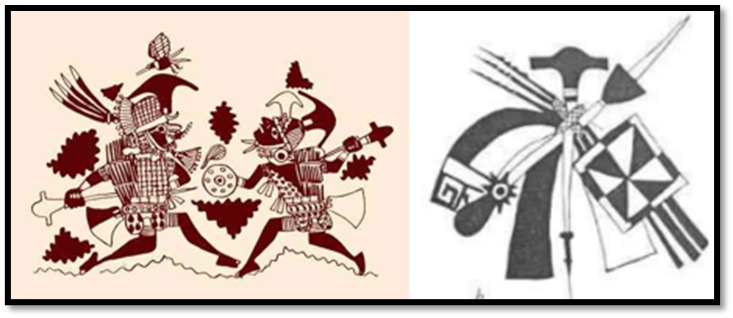
- Soldiers (especially the elite) used an estólica (javelin thrower) extensively, with some made of gold, signifying a higher rank.
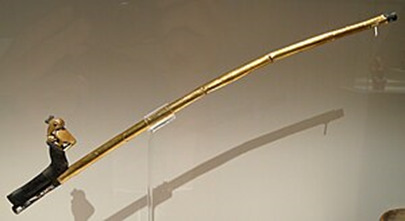
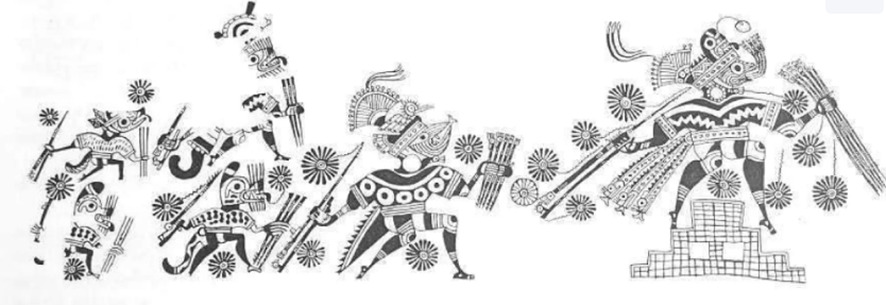
Paraeng Barracks (Vassal Barracks):
These basic barracks will be similar to Egyptian ones in that they will be used to create “counter units.” These units will be cheap and slightly faster but weaker. Similar to my concept for the Inca, all units in this barracks will have the same type of armor, with slight variations.
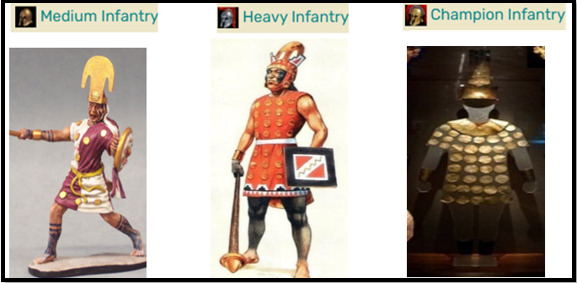
-
Clubman: Melee infantry effective only against other infantry, similar to Hypaspists.
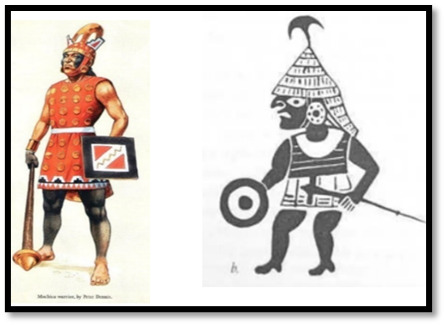
-
Hunter/Javelin Thrower: An archer that throws javelins (without a propellant), effective only against other archers, similar to the Peltast.
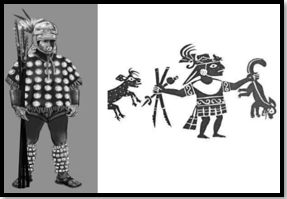
-
Runner: Shock infantry armed with a CONICAL MACE, effective only against cavalry or other shock infantry. It’s like a Katapeltes but in a shock infantry version (two-handed mace effective against cavalry), and this conical mace was lighter.
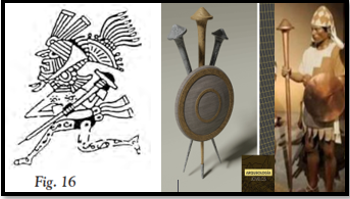
Fixl Barracks (Noble Barracks):
Advanced barracks; their units will be very expensive and powerful, but relatively slow. All these noble units will use heavy armor (with slight variations).
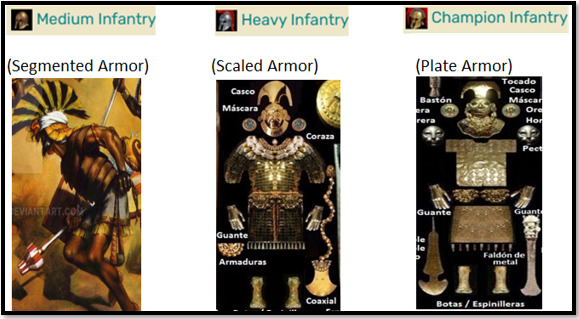
-
Maceman: A soldier armed with a BICONICAL MACE. This unit is slow but powerful, excellent against cavalry and buildings. It’s like the Katapeltes but slower, stronger, and better against buildings.
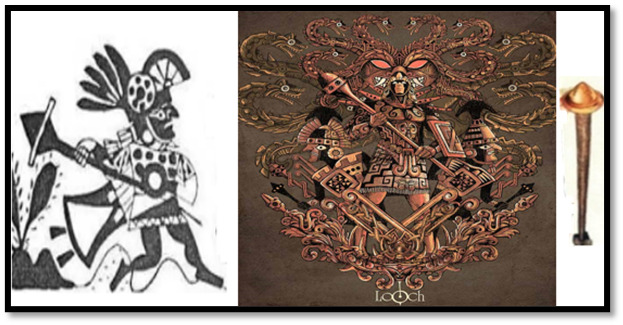
-
Estólica Thrower: Throws large javelins using an estólica. Their attack speed is slow but excellent against infantry and buildings (like the Gastraphetoros).
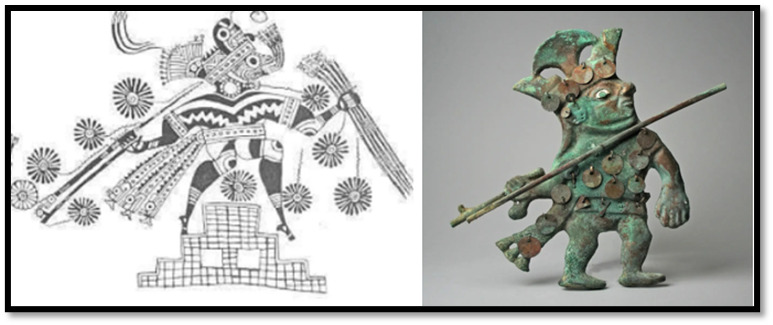
-
Raider: Shock infantry effective against archers, armed with Brass knuckles.
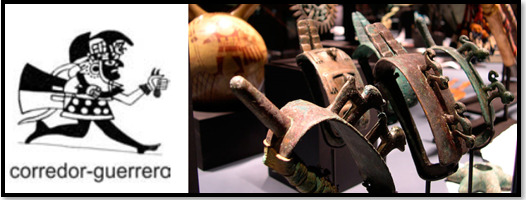
P A R # # # # # # (Fortress):
Equivalent to other fortresses; this is where royal soldiers will be trained.
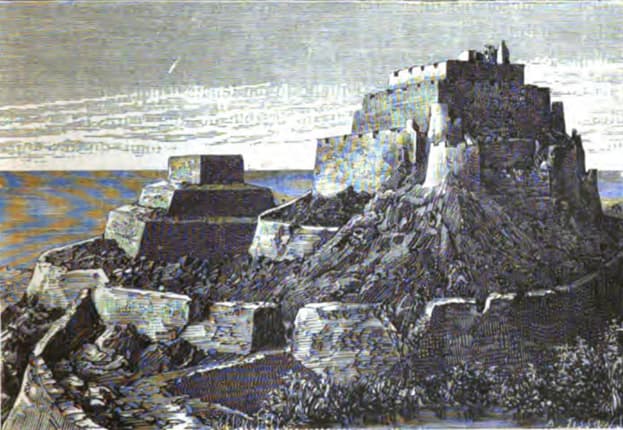
Alaec: Feudal lord armed with a serrated mace. He has area damage, can stun, and deals additional damage against buildings and myth units.

Capullana (Priestess):
A powerful ranged magical attack against myth units, capable of healing allied units.
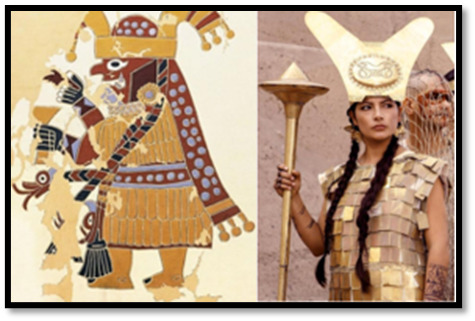
OTHER UNITS
Warrior Priest:
Melee unit effective against myth units. Since running had a spiritual meaning for the Moche, I thought this Warrior Priest should be shock infantry.
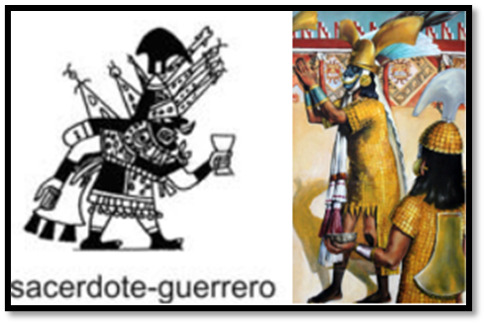
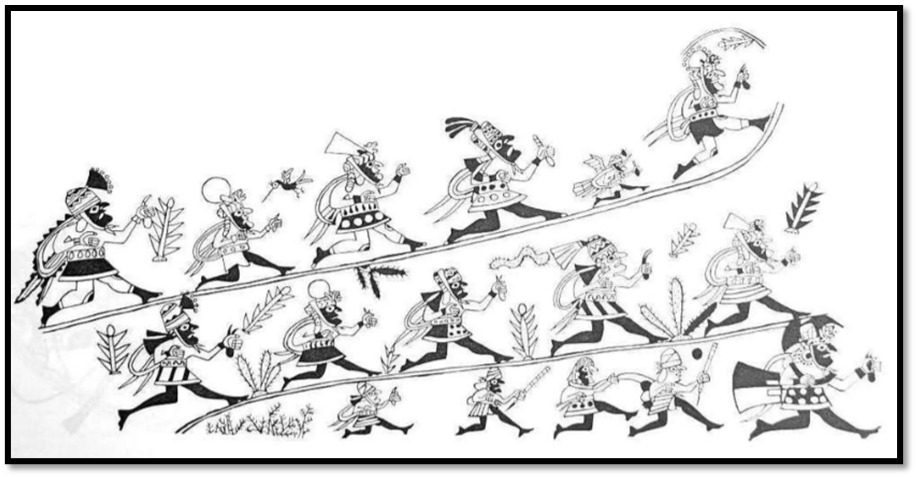
Catapult:
I found this curious artifact online, associated with the desert Pacific cultures. I’m not sure of its authenticity, but it seemed intriguing at the very least.
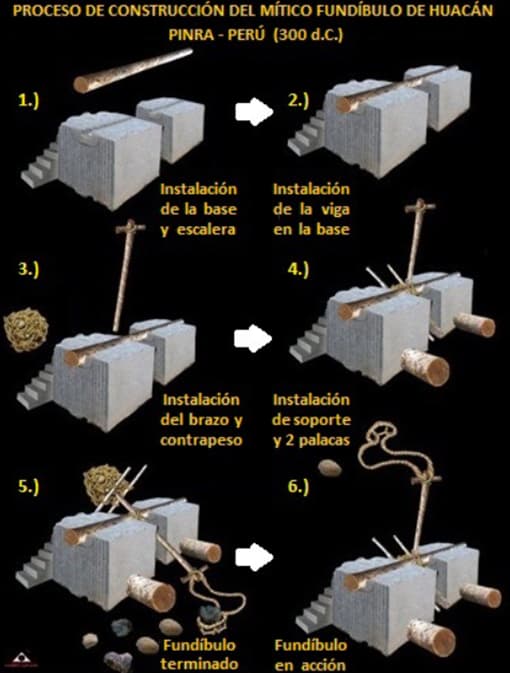
Architecture:
Adobe structures, in later ages they can be represented with paintings and reliefs.
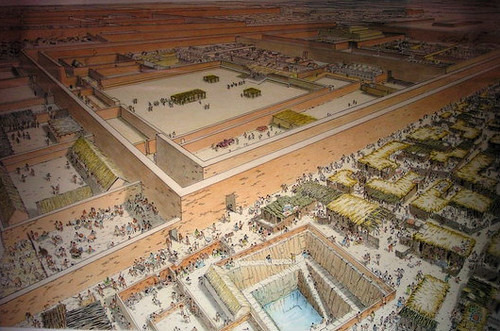
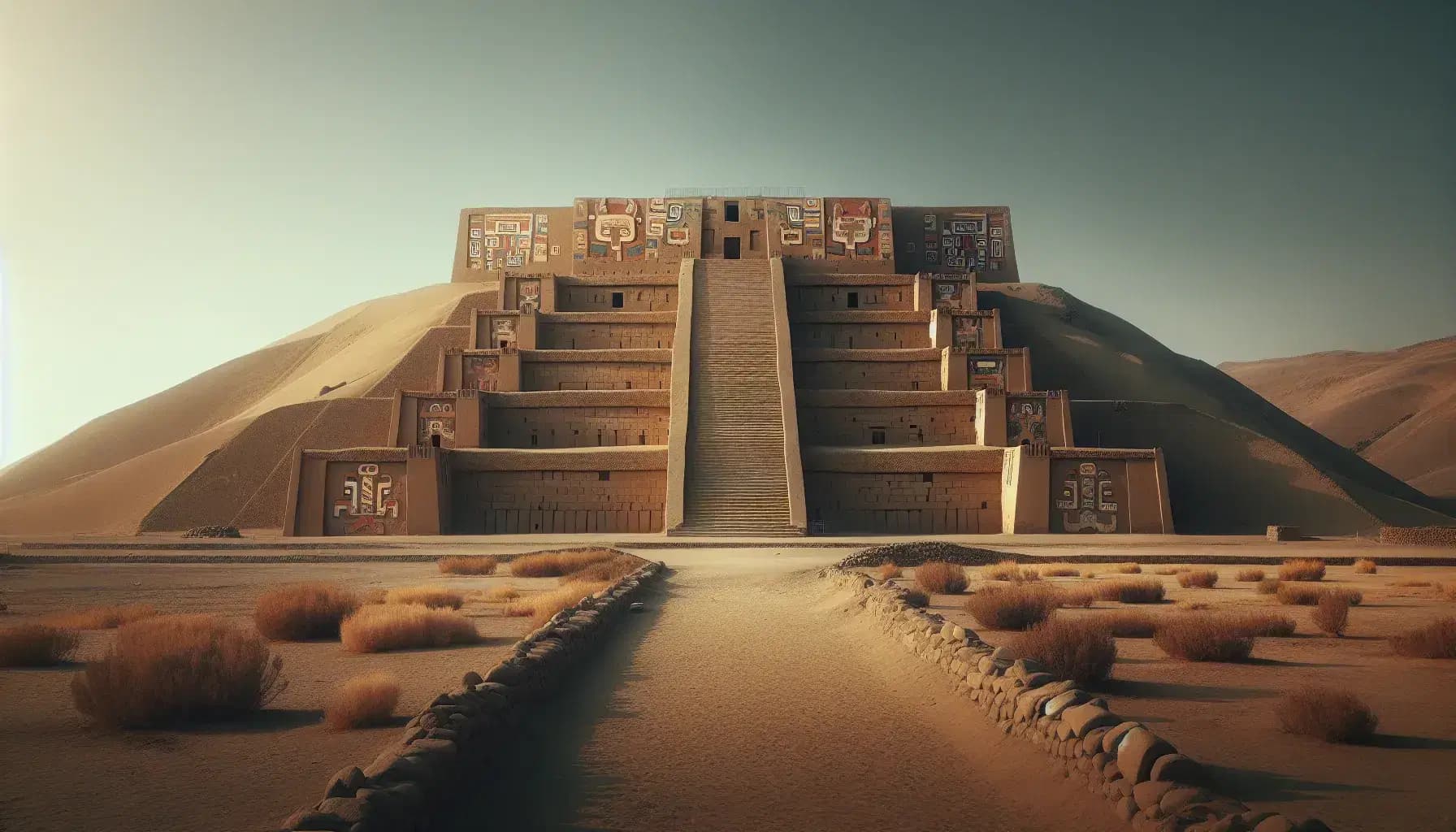
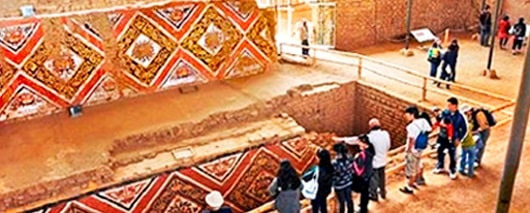
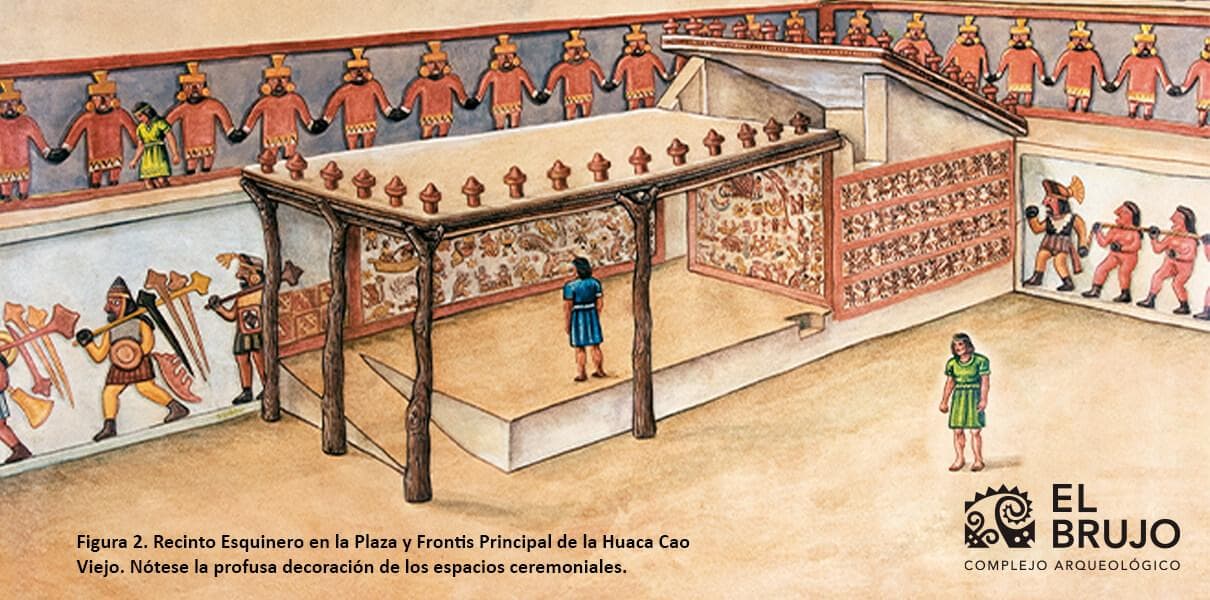
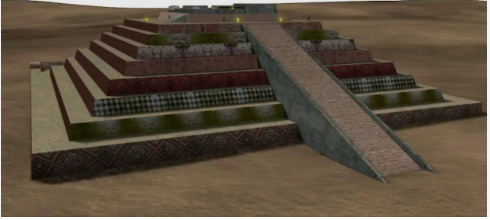
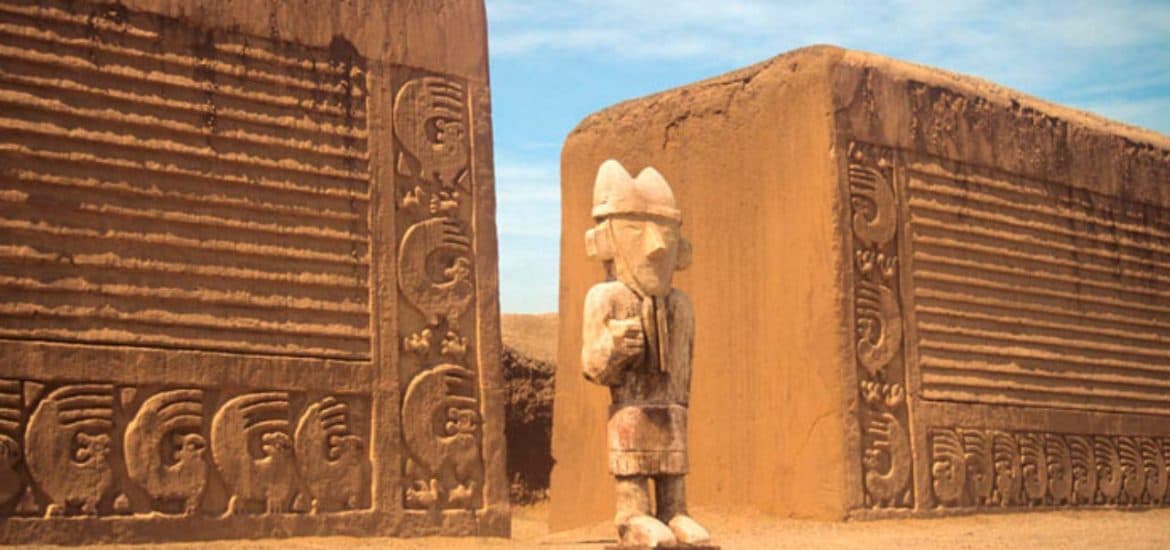
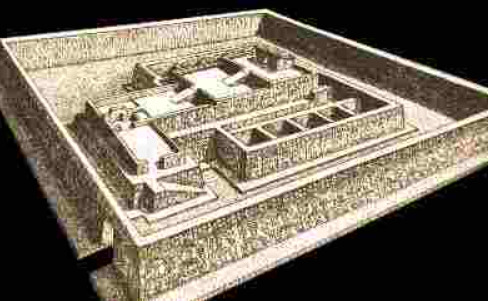
@Josh1Axel @RatcicleFan @Velk413 I think the biggest problem most fans who come up with these new and sometimes obscure pantheon ideas is the mythical units. Each pantheon has about 12-15+ mythical units.
Let’s say someone suggests the Canaanite pantheon. Now try to come up with about 12-15 Canaanite creatures from its mythology. It’s going to be hard. Almost no one would want to play a pantheon with only 2-3 mythological creatures. It is a mythology game after all.
But you could say that the developers can just come up with their own bestiary like with the Egyptian pantheon. But, I think most fans would agree to not go with this route as they want authentic and mythological based creatures from the lore.
That being said, if someone can come up with 15+ Canaanite monsters then you have my huge respect. I tried to search the web but came up short. Maybe I need to dig a little deeper or something.
I’ve thought about that too, and I keep it in mind. Even in the original Age of Mythology, there were many creative liberties taken. For example, the design of the cyclops, the minotaur upgrade called “Toro” (which literally means bull in Spanish), or the inclusion of the scorpion man, clearly inspired by The Mummy Returns. We also have the Roc from Arabic mythology, among others.
It doesn’t bother me, but it’s clear that many of these creatures are based on Ray Harryhausen’s stop-motion creations.
Obviously, by today’s standards, we might see this as a lack of faithfulness to the original mythologies. However, back in the early 2000s, it was a huge success. Many of us who played AoM at the time loved being able to see and command these creatures we had watched on TV.
Nowadays, the situation is different: we have more technology and access to information. This makes it much easier, with more than two decades of difference, to dive into the historical details and mythologies of various cultures (though with some limitations, of course). That’s precisely why I created this topic, hoping some users would contribute more knowledge about pantheons and mythical bestiaries from different cultures.
Haha, I get it. The most difficult part of creating a new faction for AoM is finding a mythology that is well-documented and diverse enough to have a coherent pantheon of gods, along with a significant number of mythical creatures. Even in the AoM: EE expansion, they faced this problem. That’s why they added creatures like the Leviathan or Behemoth, which are not necessarily tied to any specific faction.
Additionally, we often run into the issue that mythical creatures from some cultures might be completely unknown to the majority of players.
You also have to consider the “limits of creative freedom.” The inclusion of certain mythical creatures in factions outside of their culture can be justified in some cases, as long as there’s a logical or cultural connection. However, creating entirely new gods or mythical creatures is something I consider unacceptable.
One example to mention is the Atlanteans in AoM. Although they drew from a “real” mythology (the Titans), they built their civilization based on the legend of Atlantis (and that’s without including elements like war chariots and slings, which, according to legend, were common weapons in the Atlantean army) and mixed in aspects of Greek mythology. Still, they did it in a moderate way. In their case, they combined two things: Greek mythology and the culture of the Atlanteans (according to myths).
It’s precisely from the Atlanteans that I got the idea to experiment with the possibility of including Lovecraftian mythology in AoM, combining it with a faction based on the Moche/Chimú. Lovecraftian mythology is vast, diverse, and quite popular, being featured in many games. However, its main issue is that it doesn’t have a “civilization.”
On the other hand, the Moche and Chimú are fascinating civilizations, with impressive mastery of metalwork, trade, and navigation. This would break the perception that pre-Columbian cultures were just “Stone Age tribes.” However, the mythology of the Moche and much of the Chimú has been lost, leaving only their impressive iconography. So on one side, we have a well-known mythology that needs a civilization, and on the other, a civilization that lost its mythology. I think both elements could complement each other very well.
For now, I’m waiting, hoping other users will bring ideas, pantheons, or bestiaries. Obviously, we’re not experts, and our knowledge is limited to what we can gather from the internet and our local libraries ![]()
Some of them are already in the game, just move them to the correct civ:
There’s also the Golem that was cut from the final release.
Hi, I noticed you might be confusing the Canaanites with the Hebrews. While both groups lived in the same region, they had distinct origins, cultures, and religions. The Canaanites were polytheistic and already established in the land, while the Hebrews, according to tradition, arrived later and developed a monotheistic belief system. There was certainly some cultural interaction, but they were not the same people.
Interesting, I didn’t know about the Golem. Maybe they’ll add the Ziz for another civilization in the future (to complete the trilogy of Leviathan, Behemoth, and Ziz). There are also other creatures from Hebrew folklore like the Shedim, Nephilim, Dibbuk, Mazzikim, and Alukah, among others. However, I’m not sure if it would be appropriate to keep incorporating beings mentioned in the Old Testament/Quran/Torah.
I posted this speratly but i have concepts for a 4th god for Alantians, Egyptians and Greeks
Greek - Hestia
GP - Offering - Villagers gathering food generate favor over duration
UT - Prytaneum: Improves Town Centers Health, letting them heal units around them. Town Centers Regenerate
UU - Boeotians Fire Cauldron: Wooden cart encased in iron short range siege weapon that spews aoe fire Infront of it
Houses work at drop points for all resources. A portion for the dropped of resources is converted to favor instead of what dropped off
Houses have 2 garrison slots
Myth Units are cheaper
Siege units do 50% more pierce damage
Siege takes up one less pop
Wonder - Temple of Artemis or The Prytaneion of Olympia
Heroes
Archaic - Cadmus. Founder of Thebes. Would sow dragons teeth creating Spartoi to help with the city
Classic - Hector. Greatest Warrior of the Trojans
Heroic - Orion. Greatest Human Hunter and companion of Artemis.
Mythic - Medea. Powerful sorceress mounted on a chariot pulled by Dragons. Special: Invoking her AOE divine damage in an area
Unique Gods.
Classic Age - Tyche. Improves Heroes and Archers
GP - Fortune: Place a shrine, Villagers gather faster near it. Works as a drop-site for all resources
MU - Harpy. Special. Abduct: Gain burst of movement speed able to pick up a human unit and carry them briefly. Controllable for duration. Abducting a villager cause them to lose what they are carrying
UT - Lucky Break: When taking a fatal blow Heroes are knocked unconscious for 10 seconds. They can be revived by nearby ally units at 25% health. 2 minute cooldown
UT - Twist of Fate: Ranged Human units and your ranged Hero gain a special attack half their damage as divine damage.
Heroic - Persephone. Improves Myth Units and Infantry
GP - Binding Seeds: Plant a large ring of pomegranate seeds. Military units are trapped in area for the duration. At the end of the duration any units killed rise as Shades on your side.
MU - Arachne: A Spider human hybrid armed with a bow, attacks slow. Special: Fires several arrow lined with spider silk, damaging enemies and creating a slowing area on the ground.
UT - Stygian Oath: Swearing on the Styx Goddess herself to fight to their last breath, on death your infantry rise as shades to attack one more time before finally entering Hades. Infantry deal extra damage as well
UT - Hades’ Waters - Consuming the Waters of the Underworld rivers empowers your myth units. Myth units gain a temporary damage buff whenever a unit dies near them. This also reduced the cooldown of their special ability.
UT - Ferryman’s Toll: When an enemy ship or naval MU is destroyed gain gold.
Mythic - Demeter. Improves Eco and Cav
GP - Famine: Enemy Farms gather rate greatly reduced. Units gain a food upkeep, if food runs out units start losing health slowly. For duration
MU -Amazon: Relatively cheap myth unit that deals full damage to Heroes units. Easy to mass though only marginally stronger than human units. Able to switch between spear and bow. Benefit from Infantry and Archery god techs. Special: Charge into Melee dealing extra damage
UT - Thesmophoria: Farming improved, farming generates a very small amount of favor .03
UT - Arion’s Bloodline: Divine equine child of Demeter and Poseidon improves your cav giving them more hit points, speed and allowing them to heal by consuming gold
God Selection
Classic: Tyche, Athena
Heroic: Persephone, Apollo
Mythic: Demeter, Artemis
Atlantean - Nyx
GP - Midnight: Reduce line of sight of all enemies
UT - Cult of Dusk and Dawn: Oracles minimum LoS is doubled and they gain favor faster
(Seb’s Idea)
Your military building don’t appear on mini map
Free Oracle on TC or Temple construction
Generate Favor based on % of the map your opponent doesn’t have vision of
Barracks and Counter Barracks dont cost gold
Classic - Hypnos. Improve Human Units
GP - Hypersomnia: Units in target area are put to sleep temporarily, Damaging any of them will wake them all. Units will not auto target them well asleep
MU - Oneiros: Personification of Dreams. Ranged myth unit. Special: Puts a unit to sleep temporarily damaging them will wake them
UT - Restless Slumber: Upgrades Oneiros to Epiales, their special ability dealing low damage over duration, Oneiros also gain more movement speed and damage
UT - Well Rested: Idol human units regenerate
UT - Mother’s protection: Human units gain a health shield that regenerates out of combat
Heroic - Nemesis. Improves Infantry
GP - Vengeance: Kill units in target area equal to the resources of the units you recently lost in that area
MU - Erinyes (Furies) - Goddess of Vengeance. Special: Temporary damage boost when allies die near them (Stacks)
UT - Wrath of the Abandoned: Destroyers move faster and deal extra damage to ranged unit
UT - Retribution: Murmillo deal a small amount of damage back to units that melee them. Bonus melee armor
UT - Grasp of the Styx: The souls of your drowned sailors when grasp at the enemy’s hull slowing them and damaging them when your ships are sunk
Mythic - Erebus. Improves Myth Units and Ranged units
GP - Father of Monsters - Temporarily Release Typhon from his prison to wreak havoc
MU - Dracaenae: upper body of a beautiful woman and the lower body of a dragon. Special: Able to train cheaper weaker version of other myth units
UT - Shards of Darkness: Arcus deal more damage. Turma gain extra range. Attacks inflict darkness reducing enemy units LOS and range
UT - Echidna’s Brood: Upgrades Dracaenae to Dracaenae Broodmother allowing them to train units much faster. All Myth units have their armor increased.
God Selection
Classic: Hypnos, Leto
Heroic: Nemesis, Rhea
Mythic: Erebus, Hecate
Egyptian - Hathor
GP - Eye of Ra: Half the cooldown of your godpowers next use
UT - Sistrum: Labors produced slightly faster
Godpowers cost 20% less favor to recast
Pharaoh can resurrect recently killed units
Caravans cost 50% less. Free Coinage in Mythic
10% of myth units damage is converted to divine
Monuments have a ranged sun beam attack, more expensive. Units that die in range generate favor
Starts with Mafdet instead of Priest
MU - Mafdet: Frail Cheeta myth unit that gains abilities as you age up, respawns for free at Pharaoh. Fast with decent line of site. Classic, lesser empower. Gains the ability to bounce on a unit from far away dealing high single target damage and stunning target. Mythic: Better stats and bonus damage to heroes
Classic - Neith. Improves Spearmen and Villagers
GP - Unravling: The threads that bind reality comes undone, military units in an area unravel returning the resources use for them and removing them
MU - Babi: Violent Baboon. Damage increases as its health gets lower
UT - Loom: Neith weaving increases the hack armor of your Labors and Spearmen
UT - The First Mother: All military units are produced 15% faster
Heroic - Mut. Improves Heroes and Range
GP - Expedition to Punt: All your units move 20% faster
MU - Nekhbet: Egyptian Vulture, dives into attack in melee. Special: Heals whenever a nearby unit dies
UT - Madjay: Unlocks access to Nubian Archers. Archers with decent range that deal a low amount of divine damage
UT - Hatshepsut’s Legacy: Obelisks cost changed to 50 hold. Increase ally unit speed by 10% near Obelisks
UT - Pschent: Crown of a United Egypt. Improves Heroes Armor, Pharaoh always deals divine damage.
UT - The Khufu Barge: Heroic massive siege barge with extra range, more projectiles and better armor
Mythic - Tefnut. Improves Mercenaries and Myth Units.
GP - Haboob: Large area is his by a sand storm. Units and building in target area cant see outside area. units and building outside cant see into area. Enemy units in area have their LOS and speed reduced and take a small amount of constant damage well within the storm
MU - Ammit: Tough myth unit with a high attack. Special: Devourer. Ammit consumes a unit with 50% health or less
UT - Flight to Nubia: Mercenaries have part of their gold cost changed to food. Mercenary cav have part of their gold cost changed to food. They no longer decay and gain 20% extra attack
UT - End of Atenism: Myth units gain health and reduce pierce vulnerability
UT - Scarlet Lord (Maahes): Camel Riders attacks cause units to bleed
God Selection
Classic: Neith, Bast
Heroic: Mut, Sekhmet
Mythic: Tefnut, Horus
